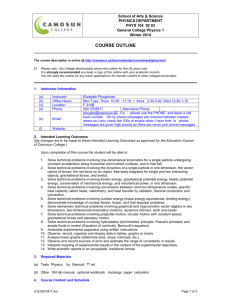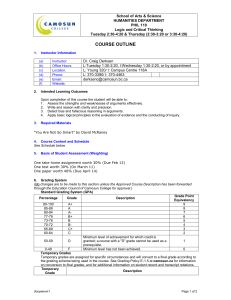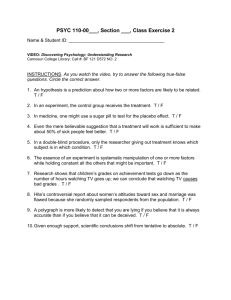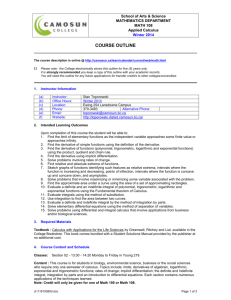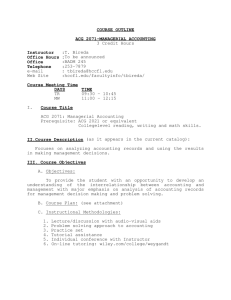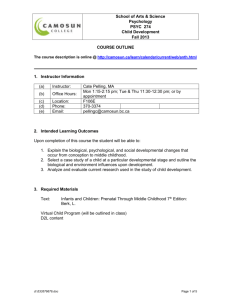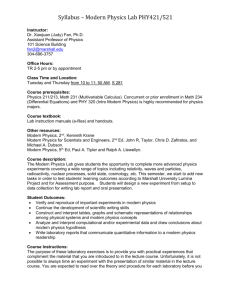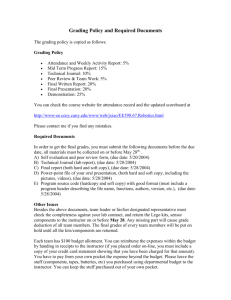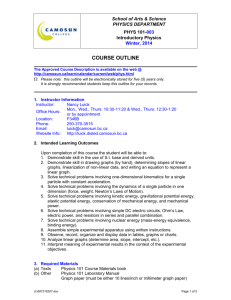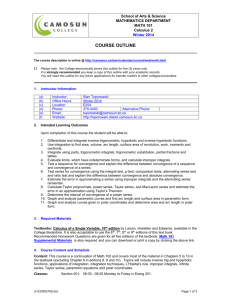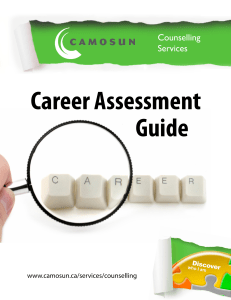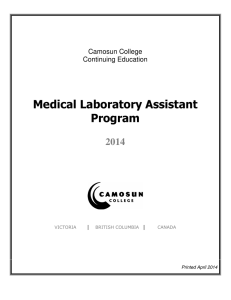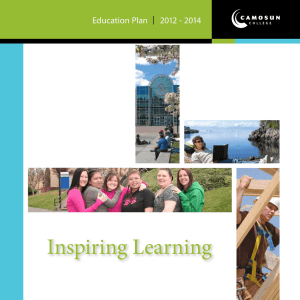PSYC 245 - Camosun College
advertisement
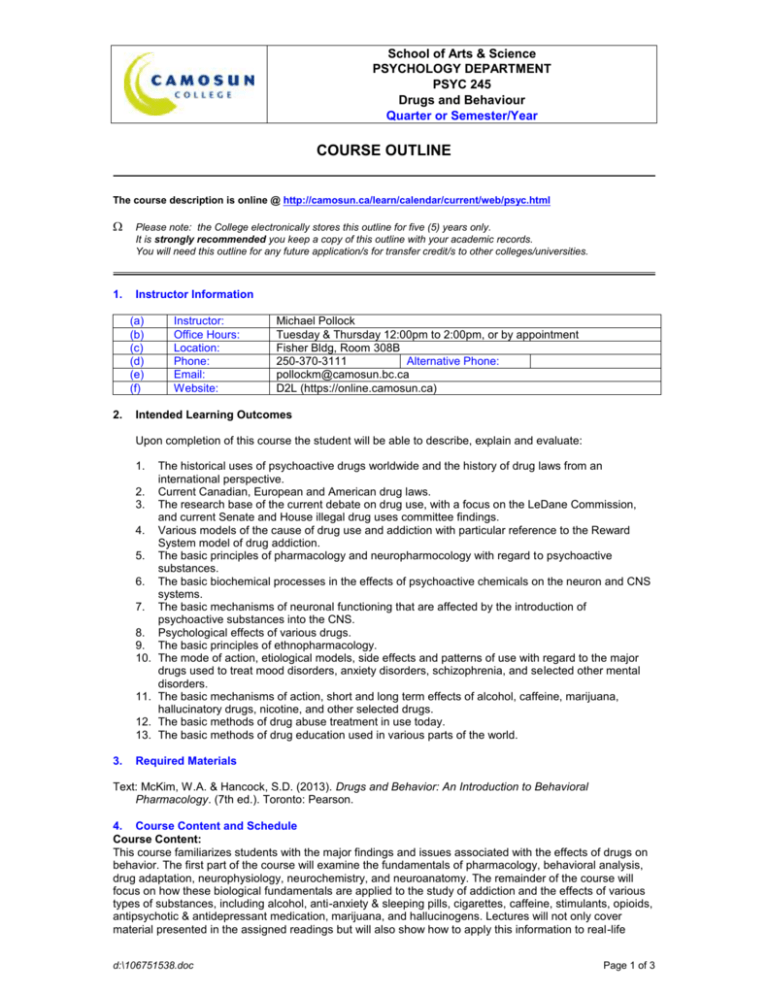
School of Arts & Science PSYCHOLOGY DEPARTMENT PSYC 245 Drugs and Behaviour Quarter or Semester/Year COURSE OUTLINE The course description is online @ http://camosun.ca/learn/calendar/current/web/psyc.html 1. Please note: the College electronically stores this outline for five (5) years only. It is strongly recommended you keep a copy of this outline with your academic records. You will need this outline for any future application/s for transfer credit/s to other colleges/universities. Instructor Information (a) (b) (c) (d) (e) (f) 2. Instructor: Office Hours: Location: Phone: Email: Website: Michael Pollock Tuesday & Thursday 12:00pm to 2:00pm, or by appointment Fisher Bldg, Room 308B 250-370-3111 Alternative Phone: pollockm@camosun.bc.ca D2L (https://online.camosun.ca) Intended Learning Outcomes Upon completion of this course the student will be able to describe, explain and evaluate: 1. 2. 3. 4. 5. 6. 7. 8. 9. 10. 11. 12. 13. 3. The historical uses of psychoactive drugs worldwide and the history of drug laws from an international perspective. Current Canadian, European and American drug laws. The research base of the current debate on drug use, with a focus on the LeDane Commission, and current Senate and House illegal drug uses committee findings. Various models of the cause of drug use and addiction with particular reference to the Reward System model of drug addiction. The basic principles of pharmacology and neuropharmocology with regard to psychoactive substances. The basic biochemical processes in the effects of psychoactive chemicals on the neuron and CNS systems. The basic mechanisms of neuronal functioning that are affected by the introduction of psychoactive substances into the CNS. Psychological effects of various drugs. The basic principles of ethnopharmacology. The mode of action, etiological models, side effects and patterns of use with regard to the major drugs used to treat mood disorders, anxiety disorders, schizophrenia, and selected other mental disorders. The basic mechanisms of action, short and long term effects of alcohol, caffeine, marijuana, hallucinatory drugs, nicotine, and other selected drugs. The basic methods of drug abuse treatment in use today. The basic methods of drug education used in various parts of the world. Required Materials Text: McKim, W.A. & Hancock, S.D. (2013). Drugs and Behavior: An Introduction to Behavioral Pharmacology. (7th ed.). Toronto: Pearson. 4. Course Content and Schedule Course Content: This course familiarizes students with the major findings and issues associated with the effects of drugs on behavior. The first part of the course will examine the fundamentals of pharmacology, behavioral analysis, drug adaptation, neurophysiology, neurochemistry, and neuroanatomy. The remainder of the course will focus on how these biological fundamentals are applied to the study of addiction and the effects of various types of substances, including alcohol, anti-anxiety & sleeping pills, cigarettes, caffeine, stimulants, opioids, antipsychotic & antidepressant medication, marijuana, and hallucinogens. Lectures will not only cover material presented in the assigned readings but will also show how to apply this information to real-life d:\106751538.doc Page 1 of 3 situations and will evaluate the practical significance of reported effects with in-class demonstrations whenever possible (albeit without drugs). In addition, in order to make learning of the material as interesting as possible, questions will be posed in class in a fun and engaging environment. COURSE SCHEDULE Date Lecture # Sep 5 Topic Assigned Readings Introduction and course outline Sep 12 1 Basic pharmacology Ch.1 Sep 19 2 Behavioral analysis of drug effects Ch.2 Sep 26 3 Adaptation to drugs Ch.3 Oct 3 4 Neural bases of behavior p.56-69,79-91 Oct 10 5 Functional neuroanatomy p.70-78,91-95 Oct 17 6 Substance use & addictive disorders Oct 24 Ch.5 Midterm exam Oct 31 7 Alcohol, anxiolytics, & sleeping pills Nov 7 8 Nicotine Nov 14 9 Caffeine, chocolate, cocaine, & amphetamines Nov 21 10 Opioids Nov 28 11 Antipsychotics & antidepressants Ch.12&13 Dec 5 12 Cannabis & hallucinogens Ch.14&15 TBA Ch.6&7 Ch.8 Ch.9&10 Ch.11 Final exam 5. Basis of Student Assessment (Weighting) Your course grade will be based on the total number of points you receive on examinations, quizzes, and an assignment, in addition to opportunities in class for bonus points. Each of these components of your course grade is described in detail below. You can check with the instructor at any time during the semester for your current class standing and you are invited to discuss any concerns about your grade. Each requirement will receive the following weight in determining your final grade: Midterm Exam: Final Exam: Quizzes: Assignment: 6. 20% 40% 20% 20% Grading System Standard Grading System (GPA) Percentage 90-100 85-89 80-84 77-79 73-76 70-72 65-69 60-64 d:\106751538.doc Grade A+ A AB+ B BC+ C Description Grade Point Equivalency 9 8 7 6 5 4 3 2 Page 2 of 3 50-59 D 0-49 F Minimum level of achievement for which credit is granted; a course with a "D" grade cannot be used as a prerequisite. Minimum level has not been achieved. 1 0 Temporary Grades Temporary grades are assigned for specific circumstances and will convert to a final grade according to the grading scheme being used in the course. See Grading Policy E-1.5 at camosun.ca for information on conversion to final grades, and for additional information on student record and transcript notations. Temporary Grade Incomplete: A temporary grade assigned when the requirements of a course have not yet been completed due to hardship or extenuating circumstances, such as illness or death in the family. In progress: A temporary grade assigned for courses that, due to design may require a further enrollment in the same course. No more than two IP grades will be assigned for the same course. (For these courses a final grade will be assigned to either the 3rd course attempt or at the point of course completion.) Compulsory Withdrawal: A temporary grade assigned by a Dean when an instructor, after documenting the prescriptive strategies applied and consulting with peers, deems that a student is unsafe to self or others and must be removed from the lab, practicum, worksite, or field placement. I IP CW 7. Description Recommended Materials or Services to Assist Students to Succeed Throughout the Course LEARNING SUPPORT AND SERVICES FOR STUDENTS There are a variety of services available for students to assist them throughout their learning. This information is available in the College calendar, at Student Services, or the College web site at camosun.ca. STUDENT CONDUCT POLICY There is a Student Conduct Policy which includes plagiarism. It is the student’s responsibility to become familiar with the content of this policy. The policy is available in each School Administration Office, at Student Services, and the College web site in the Policy Section. d:\106751538.doc Page 3 of 3
